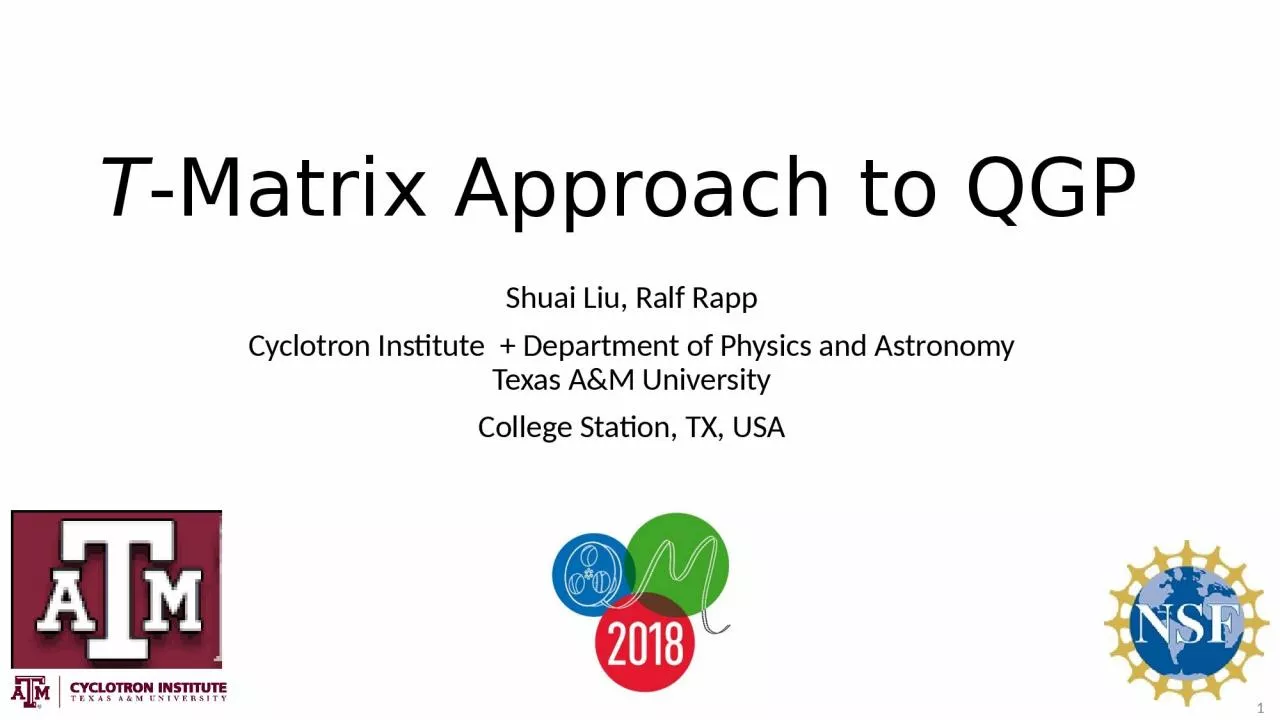

Shuai Liu Ralf Rapp Cyclotron Institute Department of Physics and Astronomy Texas AampM University College Station TX USA 1 Outline 1 Background and Motivation 2 Thermodynamic T Matrix Approach ID: 1002938
Download Presentation The PPT/PDF document "T -Matrix Approach to QGP" is the property of its rightful owner. Permission is granted to download and print the materials on this web site for personal, non-commercial use only, and to display it on your personal computer provided you do not modify the materials and that you retain all copyright notices contained in the materials. By downloading content from our website, you accept the terms of this agreement.
1. T-Matrix Approach to QGPShuai Liu, Ralf RappCyclotron Institute + Department of Physics and AstronomyTexas A&M UniversityCollege Station, TX, USA1
2. Outline1) Background and Motivation2) Thermodynamic T-Matrix Approach3) Studying the Microscopic Structure of QGP4) Conclusion and Perspective2
3. An Many-Body Approach3The ability to reduce everything to simple fundamental laws does not imply the ability to start from those laws and reconstruct the universe --P. W. Anderson QCD Lagrangian Quantum many-body theoryQuantum many-body theory QCD Lagrangian T-matrix approach:in-medium color force,equation of state, spectral functions,transport propertiesSolve a problem!In-medium color forceS.Liu+RR’ 17HotQCD, 14EoSSpectral propertiesS.Liu+RR’ 17CMS, 17Transport properties
4. The Starting Partonic HamiltonianIn-medium Hamiltonian-effective in-medium mass Interaction ansatz: Cornell potential with relativistic correction- color Coulomb and string (“confining”) interactionStarting point for many-body approach[Liu+RR 16&17]4 J. Richardson,79Recover QCD at HQ limitInclude the confining interaction effectively (nonperturbative effect)Inputs: and
5. Thermodynamic T-Matrix Approach Self-consistent self-energy: T-matrix equation: 5Many-body diagramsDynamical bound states generation (nonperturbative effect)Scattering states in equal footing Thermodynamic potential: Luttinger–Wald functional (LWF):
6. Inputs and ConstraintsExisting multiple solutions for and consistent with these data Inputs: and Constraints: lattice EoS, lattice free energy, lattice correlator ratio 6HotQCD, 14G.Aarts,07Mocsy, Petreczky, Strickland,13Lattice EoSLattice free energyLattice correlator ratior [fm]2 Tcr [fm]1.2 Tc(T-matrix)Quark MassGluon Mass Remnant of long-range “confining” force (vacuum structures) in QGP S.Liu+RR’ 15 and 17 Decoupling of the gluons around due to large mass Strongly coupled solution
7. Transition of Degrees of Freedom Pressure[S.Liu+RR 16, 17]7Mixture of quarks and hadrons with strong mutual transitions (board width) Broad hadronic resonances emerge near , dominate EoS Mesonic S wave Parton spectral functionImaginary part of T-matrix
8. Charm BottomParton Spectral Functions in QGP Up/Down + Gluon QGP structure changes with resolution scale Soft parton quasi-particles dissolve but re-emerge with increasing , p Similar width (~1 GeV) for all quarks allowing heavy quark probe for light partons properties 8Stay quasiparticle,clean prober [fm]1.2 TcFlattice dataV
9. Weakly Coupled Solution & Strongly Coupled Solution Existing weakly coupled solution besides the strongly coupled solution discussed in previous slides9 r [fm]1.2 Tc(T-matrix)(Strong)V (Weak)Solid: Full ResultDashed: LWFWeak, StrongSmall two-body resonancesA weak string potentialSharp (quasiparticle) spectral functionsSufficient condition:Strong two-body resonancesA large string potentialbroad (non-quasiparticle) spectral functionsSufficient condition:Strong two-body resonancesA large string potentialbroad (non-quasiparticle) spectral functionsTransport properties of QGP (shown in next slide)If “weak =strong”,“sufficient and necessary ” :
10. Viscosity and Heavy-Quark Diffusion Strongly coupled: Perturbative: Transition as T increases 10Strongly coupled limit ViscositySpatial diffusion coefficient:Strongly coupled solution preferred by experimental observables
11. Conclusion and Perspective11Many-body T-matrix approach consistent with:-Three lattice QCD data (EoS, Free energy, Quarkonium correlator)The solutions can predicts the correlations:-A strong force with large remnant string term not far above -Strong broad resonance states at low temperature and transition of degrees of freedom-Broad non-quasi-particle spectral functions at low temperature low momentum -Transport properties of the QGP (small , small ) Experimental observations suggest the microscopic structure of QGP is closer to strongly coupled scenario predicted by T-matrix approachIn the future: finite density physics, non-perturbative radiative energy loss, improving starting Hamiltonian.... More details in: “SYF Liu, R Rapp, PRC, 97, 034918, 2018”, “SYF Liu, R Rapp, arXiv:1612.09138”
12. Quarkonium Euclidean Correlator (SCS)Intermediate dissociation/regeneration rate for quarkoniumSequential dissociation/regenerationNo strong temperature dependence of 12
13. Langevin simulation of HQ Viscosity and Heavy-Quark Diffusion13
14. Preliminary for Quark Number Susceptibilities 14Heavy light susceptibilitiesPreliminary ResultsLight quark susceptibilitiesT(GeV)T(GeV)Preliminary Result
15. Relaxation Rate15Preliminary ResultsRadiative Induced Relaxation Rate 1/fmp(GeV)Collision induced Relaxation Rate